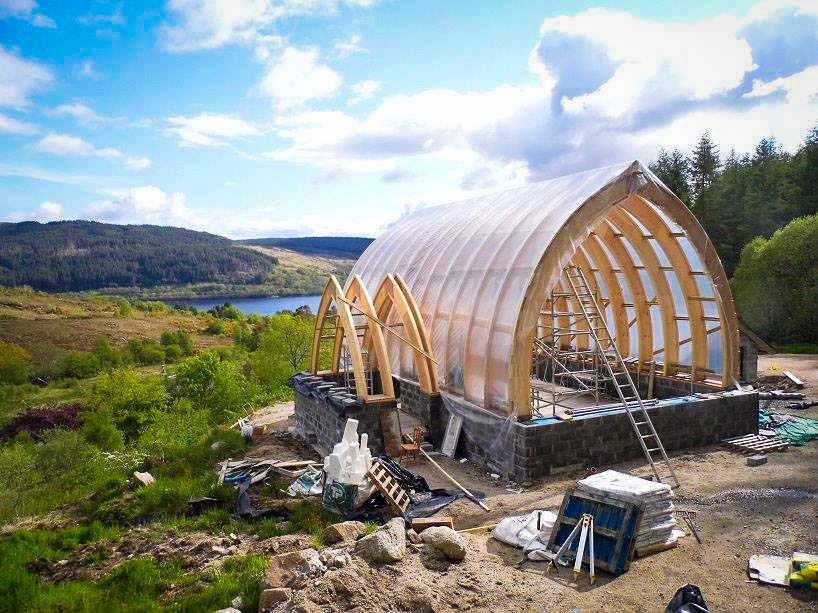We’re all besotted with buildings. So much so that the average person spends 90% of their lifetime indoors. Buildings make our lives more comfortable and convenient; imagining a world without them is near-on impossible. And, to be fair, some of the buildings across our city’s skylines are pretty impressive. With so much time, money and thought going into the process that generates a (hopefully) attractive-looking structure, let’s start investing just as much energy into building them sustainably. Keep reading to find out why it’s about time we put our best foot forward towards sustainable construction.
Perhaps it is a slightly paradoxical idea that we can build our way out of the climate crisis, but bear with me for a moment. The UN offered this definition as part of the Our Common Future report, and the crux of it is still relevant today:
“Sustainable development is development that meets the needs of the present without compromising the ability of future generations to meet their own needs.”
In other words, we need to do what we can to cover every single person’s basic requirements across the entire world – something we are yet to achieve – but anything we do today mustn’t endanger the ability of our children or our children’s children to be able to live in the same way and enjoy the same Earth as we do. That means anything from economic advancements and technological progress to societal changes and lifestyle improvements. A pretty big task, when you think about it.
And yet, when you think about it, it is definitely possible.
Calling on Construction: Circles, Not Lines

Circular buildings, circular architecture and developing a circular economy are all buzzwords that have increasingly been cropping up recently – bad news for flat earthers but good news for sustainable construction. So put away your rulers, it’s time to start thinking in circles… not literally, rulers are quite important for designing buildings.
Sustainability can be depicted as a stool with three legs, all of which are required to fulfil the sustainability criteria: environment, economics, equity.
Sustainable construction, more specifically, also incorporates three main elements:
- Using renewable and recyclable materials.
- Reducing energy consumption.
- Cutting down on waste.
Jarred Metoyer writing about the best practices in sustainability says that both utilities and cities share a mutual interest in developing “smarter”, “greener”, and “safer” built environments. It is about being innovative, doing a 180 on current practices and coming up with holistic future-proof solutions.
“Human beings don’t have a pollution problem; they have a design problem.”
Braungart and McDonough1
So, What’s the Hold-Up?
It is estimated that around 80% of buildings we see today will still be standing in 2050. So, why aren’t we developing more sustainably already?
Given that the majority of us may be city dwellers very soon (yes, that includes you), read on to find out just a few reasons why sustainable construction is the best course of action.
The Case For The Environment
We’ve all heard that the weather is getting warmer, the ice caps are melting, the sea levels are rising, and the earth is essentially heading down a dead-end with deadly serious consequences. So, let’s cut to the chase: the two primary causes of climate change are transportation and buildings. Given the amount of time spent indoors, where the levels of certain pollutants can be as much as 2 to 5 times higher than usually found outdoors, it seems a no-brainer that we need to make some changes to the built environment.
It’s an unavoidable fact that globally the buildings and construction industry and the buildings themselves account for approximately:
- 35% of energy consumption
- 50% of greenhouse emissions
- 11% of total global emissions come from embodied carbon in construction – from construction, demolition and the wider supply chain
- 40% of raw materials
In the EU alone, construction and demolition produce around 1/3 of the total amount of waste generated annually. One of the most attractive reasons for people investing in sustainable builds is the improved energy performance. This follows trends of trying to achieve net zero, near zero and energy positive buildings. The UTC’s Center for Intelligent Buildings in Florida is an example of this paying off. With a 60% reduction in energy use, they are removing 988 tons of greenhouse gases every year.
The Case For Society: Buildings Helping People
“Yet sustainability does not begin and end with reducing carbon. The buildings we work in define and shape their neighbourhoods, especially in cities, where they have an enormous social impact on communities.”
Craig Scott

The World Green Building Trends 2018 report stated that as well as green building activity increasing, there had also been a rise in the influence of social factors, and they’re pretty convincing too. Here are the top 5:
- Promotes improved occupant health and well-being
- Encourages sustainable business practices
- Increases worker productivity
- Creates a sense of community
- Supports the domestic economy
The Case For Equity: Establishing Equity One Brick at a Time
Although equity is part of the sustainability triangle, it can often seem like more of an “afterthought”. Equity in construction is about ensuring fairness in the built environments we are creating rather than sustainable design being a luxury.
The #BuildingResilience movement talks about a built environment that delivers “healthy, equitable and resilient buildings, communities and cities”, including “fair access to vital social infrastructure like schools, hospitals and green spaces”. It goes without saying that we are still a long way off from achieving this for everyone, however, if we continue doing what we’ve always done, then nothing will ever change.
Critical areas addressing equity may include:
- Housing types and affordability
- Design for accessibility and easy mobility
- Community outreach and involvement
- Identifying needs and disparities in the community surrounding the project
- Local material production
- Local workforce and under-represented firms throughout the supply chain
- Equity within the project team, including workforce development, workforce wages, demonstrating corporate responsibility
Jennifer Hirsch claims that highlighting and working towards equity in the construction industry is not just a “feel-good endeavour” but that “leading companies have long recognised that diverse talent is more likely to innovate”.
In 2018, the NAACP stated that it is communities of colour and those with low incomes who suffer most from the “unhealthy, energy inefficient, and disaster vulnerable buildings”. These people are exactly those who are missing from construction sites, design teams and discussions around sustainable building.
The Case For Our Health: Living and Breathing Sustainability
Constructing healthier buildings seemed to be of highest importance in Brazil, China, India, South Africa and the U.S. Now, you might be asking yourself, how is a building going to make me healthier? It’s all down to the materials, for example:
- Lead found in paint, water pipes, contaminated soil and older housing stocks – there is no safe level of lead in the blood and is particularly dangerous for children.
- Flame retardants are applied to products such as furnishings, electronics and insulation materials. While they are good at preventing fire, there is evidence that they may also impact the immune system and child development, cause thyroid disruption and cancer.
- Concrete – a much-loved material for construction – but perhaps not the healthiest one. Alternatives, like hempcrete, improve the air quality in the building because they are breathable and pest-/mould-resistant due to the way it regulates humidity.
The Case For Economics: Sustainable Buildings Bringing in the Big Bucks
Although we may not always like to admit it, financial incentives are, more often than not, the most effective drivers of change. Rather than companies adopting sustainability strategies in order to be ‘eco-friendly’, they are now doing so as a way to increase profits making the environmental factors just “an added bonus”.
Not only that, but Tine Hegli (Snohetta) and Katharina Bramslev (Norwegian Green Building Council) both predict the necessity of being environmentally conscious in order to have a bright future and make a living, whether as a company or as an individual. Bramslev states that sustainable construction will be “the only way to survive in the marketplace” in the future.
“Environmental goals are crucial to anyone who wants to get noticed in the world of architecture these days.”
Tine Hegli, Senior Architect at Snohetta
So, following Darwin’s theory of survival of the fittest, start building sustainably!
Naturally, the question on everybody’s lips is whether it is financially viable. The good news is that as the market has adapted over recent years, there are now very few added costs to designing commercial buildings in a sustainable way. The research and technology exist; it is more a question of will.
Contributors from across the world took part in a green building survey in 2018 reporting various business benefits:
- Operating cost savings
- Short payback periods
- Increase in asset value from investments in new green buildings and green retrofit projects
In fact, over ¼ of architects and contractors asked, said that building sustainably adds more than 10% to the value.
The Case For Sustainable Construction in a Nutshell
Although we should all be focused on the overwhelming environmental, social, and health benefits of sustainable construction, it is safe to say that money makes the world go round, and economics lies at the heart of sustainability:
“There’s no point building a really sustainable building that people don’t want to be in.”
Neil Pennell
We’re all a little afraid of the unknown; it’s human nature, and the construction industry is no different. Promoters of sustainable construction may be a little quieter than other environmental activists, but maybe they should have a free pass to be a little more attention seeking.
It may not be easy adapting the entire construction industry to a more future-proof way of working, dispelling the belief that such drastic changes will leave you out of pocket while inciting others to consider the vital steps towards equity that the world needs to be sustainable.
So now we know where the problem lies, what the solution is, and how we’re all going to gain from it in the future, it’s time to leave the concrete in the past and start embracing mud, straw and wood once again. Head over to our article to find out how to get started.
(1) Braungart, M. & McDonough, W. (2013). The Upcycle: Beyond Sustainability – Designing for Abundance. New York: Farrar, Straus and Giroux.


